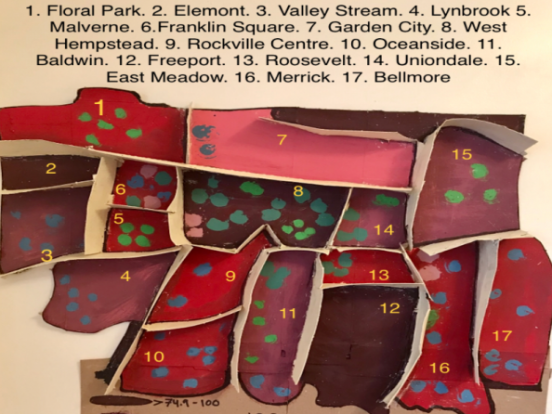
Historically Long Island was one of first suburban places in America. In the decades following World War II the island’s population began to flourish. As home prices increased in the suburbs, downtown and urban areas became more highly populated, impoverished and racially segregated. As home prices rose and the suburbs gentrified, the previous residents were pushed out. Now, Long Island is a highly populated place however diversity and equal access to housing is not equal across the island. There are invisible walls built around each town, keeping each town racially segregated. The map represents the southern portion of Nassau county. It illustrates the percent of minority population in each town and overlays realtor home showing patterns from a Newsday study. Newsday studied what areas potential home buyers are shown by sending actors as potential homebuyers to practicing realtors. They found that realtors grouped buyers together based on their ethnicity and race while also steering them to buy homes in certain towns because of their race. Housing segregation on Long Island is a clear example of the inequalities that come about when urban places began to empty and suburbs started to gentrify. The injustices of housing segregation directly impacts the sustainable development of a place through health and education of individuals. Racially segregated towns often end up with vastly different resources and wealth which affects the quality of the school district and what businesses thrive. A just, sustainable development for the future, goes beyond the “green movement” focusing on the current or intra-generational inequality and injustices that live in our society today. Housing segregation is an injustice that hinders the creation of just sustainable future for everyone.

levinana
May 1, 2020 — 5:43 pm
I really liked your use of symbolism with the built walls separating different neighborhoods. This is definitely an important issue and you did a nice job representing it so efficiently!
bromleyd
May 1, 2020 — 5:46 pm
Racial zoning is something that has been set up through many decades in a very systematic way, and to see it still so prevalent today is really disheartening. So many people don’t even realize it’s still happening, but it is such a normal practice. Assuming you live in Long Island, was it easy for you to see these patterns before this project or did it make you realize how bad it still was?
FS
May 1, 2020 — 6:07 pm
Thank you. Yes I do live on Long Island and as I got older I started to see how racial segregated the island had become.
meltmarr
May 1, 2020 — 5:53 pm
I like the symbolism with the walls separating each neighborhood. The walls are set up by the racist realtors. That podcast we listened to in February was very informative and I never would have known about this.
Hiba
May 1, 2020 — 5:55 pm
I really like how your map is 3D and how you symbolically represented the invisible walls that leave different towns racially segregated. Great tie in between sustainable development and housing discrimination too!
palaciom
May 1, 2020 — 5:56 pm
It is really disheartening to see how racist acts are still being practiced in 2020. This only further shorten’s ones social mobility as well as the different resources that become difficult to access for people of color.
Allison Acevedo
May 1, 2020 — 6:05 pm
I like that you research housing issues and consider these as part of the environmental justice/environmental landscape. As you mention housing relates to resource development, education and health care. Projects like this will prompt us to consider and plan in a wholistic way and begin to remove silos of working in certain program and service areas.
messimeg
May 1, 2020 — 6:07 pm
I love how you used physical walls in the visual to represent the separations, and I think that the research on this is very well done and you displayed it in an easy to understand and efficient way!
brownemm
May 1, 2020 — 6:34 pm
I really loved your visual, just a cool way to highlight this issue. I also really was interested to learn about this issue in class and through this project because I live so close to Long Island and communities that are affected! I’m interested to see how this issue develops as housing prices in the greater NYC area continue to skyrocket and I wonder if better protections will be established or if gentrification will continue unabated?
Prof. Heiman (emeritus)
May 1, 2020 — 6:34 pm
Nassau County provides an instructive lesson on housing discrimination and racial segregation–both with housing as well as accompanying school districts. Historically some of the communities, such as East Meadow and Levittown, were built for sale to returning WWII GI vets and were supposed to be inclusive. I gather it didn’t turn out that way. https://projects.newsday.com/long-island/segregation-real-estate-history/